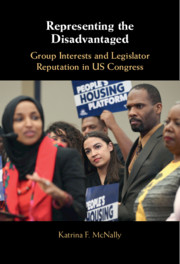Appendix D Generalized Ordered Logit Model Showing Effects of Constituency and Descriptive Representation on Reputations for Women’s Advocacy
Table D-1 displays the models of the effects of group size and ambient temperature on women’s advocacy that were presented in Table 5.6, but with descriptive representation included. These models show that the relationship between the percentage of women in a state and reputation formation seen in Table 5.6 is in fact a spurious correlation that is better explained by whether or not a state’s senator is a woman.
Table D-1 Group size, ambient temperature, descriptive representation, and member reputation for advocacy for women
| Women | ||||||
|---|---|---|---|---|---|---|
| 0 | 1 | 0 | 1 | 0 | 1 | |
| Group | 0.256 | −0.173 | 0.261 | −0.191 | ||
| Size | 0.34 | 0.74 | 0.33 | 0.76 | ||
| Ambient | −0.069 | −0.095 | −0.074 | −0.063 | ||
| Temperature | 0.17 | 0.37 | 0.14 | 0.65 | ||
| Descriptive | 3.551 | 3.938 | 3.523 | 4.196 | 3.642 | 3.983 |
| Representative | 0.00 | 0.00 | 0.00 | 0.00 | 0.00 | 0.00 |
| Republican | 0.038 | 0.124 | 0.066 | 0.274 | 0.088 | 0.176 |
| 0.92 | 0.87 | 0.87 | 0.72 | 0.82 | 0.84 | |
| Dem Pres | 0.032 | 0.108 | 0.044 | 0.102 | 0.034 | 0.112 |
| Vote | 0.26 | 0.01 | 0.10 | 0.04 | 0.23 | 0.01 |
| South | −0.847 | 0.738 | −0.591 | 0.637 | −0.812 | 0.806 |
| 0.05 | 0.36 | 0.13 | 0.44 | 0.06 | 0.32 | |
| 1990s | 2.045 | 1.494 | 2.100 | 1.264 | 1.978 | 1.451 |
| 0.00 | 0.06 | 0.00 | 0.06 | 0.00 | 0.09 | |
| 2000s | 0.450 | −0.098 | 0.755 | 0.046 | 0.676 | 0.136 |
| 0.28 | 0.87 | 0.09 | 0.93 | 0.13 | 0.80 | |
| First | −1.531 | −1.501 | −1.524 | |||
| Term | 0.00 | 0.00 | 0.00 | |||
| Constant | −18.131 | −2.186 | −2.177 | −5.471 | −14.549 | 1.940 |
| 0.18 | 0.93 | 0.49 | 0.24 | 0.30 | 0.94 | |
| N | 500 | 500 | 500 | |||
| Wald’s Chi2 | 80.0 | 64.7 | 84.0 | |||
| Pseudo-R2 | 0.2875 | 0.2857 | 0.2908 | |||
Note: Coefficients calculated using generalized ordered logit, with First Term modeled as a parallel proportional term and all others as partial proportional terms. Standard errors are clustered by member, and p-values are in gray. Model 0 represents the likelihood of a shift from no advocacy to superficial or primary/secondary advocacy, and Model 1 is no advocacy or superficial advocacy to primary/secondary advocacy.

